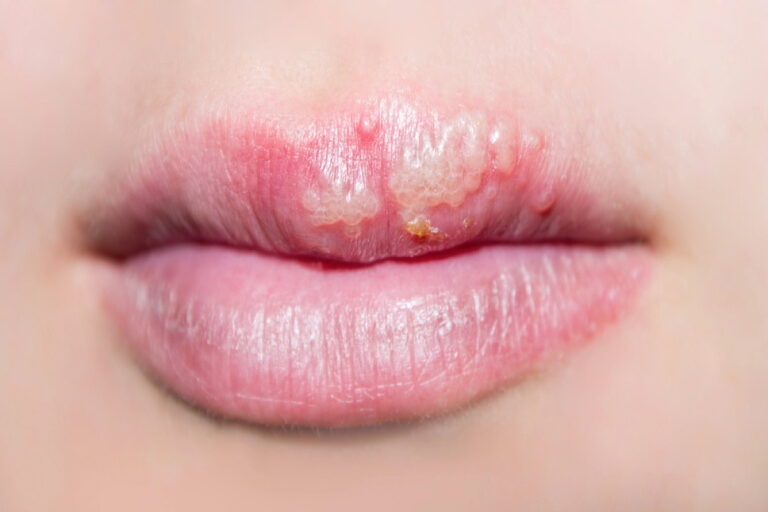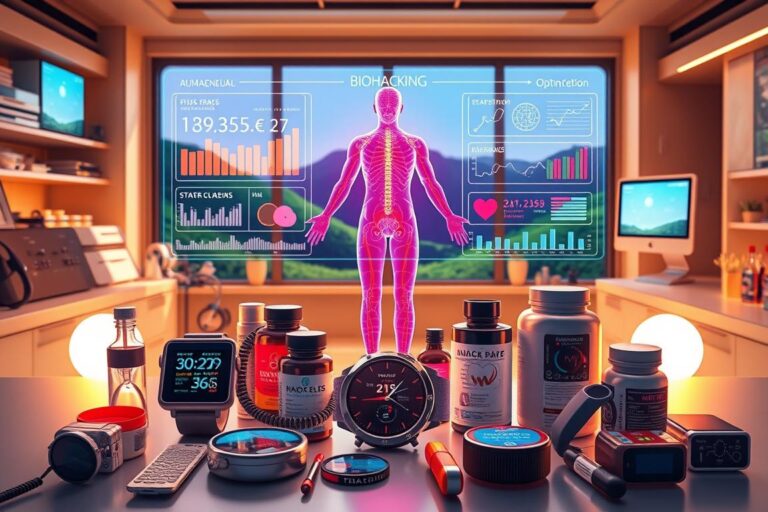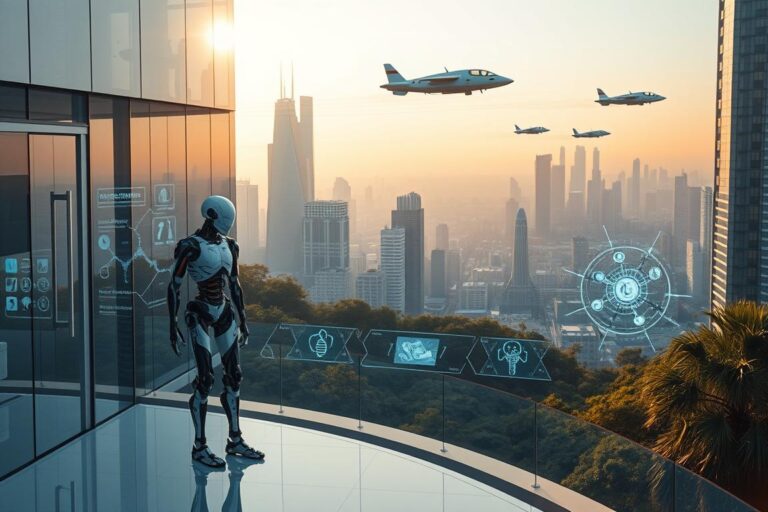Light pollution – How artificial light disturbs our sleep
Did you know that the annual increase in light pollution in Germany is around six percent? This alarming figure shows how much artificial light illuminates our nights and thus disturbs our sleep. Artificial light, especially blue light from LEDs, suppresses melatonin production and leads to sleep disorders. In urban areas, there are often only a few bright stars visible, which indicates high levels of light pollution and impairs sleep quality.
Adequate darkness is essential for good melatonin production and undisturbed sleep. Light pollution causes a delay in falling asleep and can affect both physical and mental health. Studies have shown that street lighting is associated with sleep disturbance and stress in residents. Fortunately, blue light filters and dark curtains can help reduce the negative impact of artificial light.
Important findings:
- The annual increase in light pollution in Germany is around six percent.
- Artificial light, especially blue light, disrupts melatonin levels and sleep patterns.
- Sufficient darkness is essential for good melatonin production and undisturbed sleep.
- Blue light filters and dark curtains can help to reduce the negative influence of artificial light.
- In urban areas, often only a few bright stars are visible, which indicates a high level of light pollution.
- The Earth Night initiative promotes the reduction of lighting to support darker nights and better sleep.
What is light pollution?
Light pollution is defined as the excessive or misguided use of artificial light sources that outshine the natural darkness of the night sky. In urban areas in particular, permanent sources of illumination such as street lamps, advertising signs and illuminated monuments create a constant dome of light that prevents the sky from becoming dark even at night.
The definition of light pollution also includes the fact that artificial light disrupts the natural balance between day and night. This not only affects human health by suppressing the production of the hormone melatonin, but also has far-reaching ecological consequences for the ecosystem. For example, nocturnal insects become disoriented by artificial light, which has a negative impact on pollination and the food chain.
According to recent studies, around 80% of the world’s population live in light-polluted areas, which can lead to sleep disorders and long-term exhaustion. In addition, light pollution has increased dramatically in recent decades – by as much as 49% between 1992 and 2017. This statistic illustrates the increasing relevance of the problem and the urgent need for measures to reduce artificial light.
How artificial light causes light pollution
Light pollution caused by artificial light sources has numerous negative effects on the environment and human health. The causes of light pollution are manifold and are mainly based on inadequately designed or misplaced street lighting.
Reasons for light pollution
One significant problem is unintentional stray light. This is light that is not directed to where it is needed, but illuminates the sky. This often occurs with poorly aligned lighting fixtures. The illumination of buildings and billboards also contributes significantly to light pollution, especially in large cities and busy industrial areas. The annual increase in artificial lighting is around 10%.
Exemplary sources
The most common sources of light pollution include street lighting, bright windows, façade lighting and billboards. These artificial light sources attract nocturnal animals and disrupt their natural behaviors. For example, migratory birds are distracted by light and turtle larvae on coastlines are misled, which can lead to their death. Insects are also attracted to streetlights, which has a significant impact on local ecosystems.
Local initiatives, such as night-time lighting bans at monuments and the use of warm white light sources, are crucial steps towards reducing light pollution. By understanding the causes of light pollution and the role of street lighting, we can take measures that protect both the environment and our health.
How light pollution disturbs our sleep
Light pollution has far-reaching effects on our sleep quality. Artificial light sources, especially those with a high blue component such as LEDs, inhibit melatonin production. Melatonin is a hormone that is necessary for healthy sleep. If melatonin production is disrupted, various sleep disorders can arise.
More and more people are suffering from problems falling asleep caused by artificial light. Even slight exposure to light at night can lead to the internal clock no longer knowing when it is time to go to sleep. This can lead to profound sleep problems, which in turn have a negative impact on health. Studies show that poor sleep quality increases the risk of depression and cardiovascular disease.
Mice that are exposed to an unnatural light-dark cycle age faster and tend to be overweight. Such lighting conditions also lead to similar health problems in humans. Artificial light not only disrupts melatonin production, but also influences our natural light rhythms. The earth is getting brighter at night, disrupting natural rhythms and negatively impacting the environment. Blue light from electronic devices like TVs and smartphones can interfere with sleep patterns, exacerbating the problem.
To combat this, it is recommended to use blue light-blocking glasses and adjust light colors throughout the day. These measures can help to regulate melatonin production and reduce the negative effects of light pollution on sleep.
Light pollution disrupts the biorhythm
The constant presence of artificial light, especially at night, can significantly disrupt the natural rhythm of light and dark periods. Light pollution disrupts the biorhythm and has a profound effect on our body and our well-being.
One of the best-known consequences is the suppression of the production of the “sleep hormone” melatonin by too much artificial light. This leads to sleep disorders and can cause serious health problems in the long term. According to a study, light pollution in Germany is increasing by around 6% every year, which further exacerbates the problem.
However, the effects are not limited to humans. Animals and plants are also affected. Birds, for example, can become disoriented by artificial light, leading to collisions with buildings and altered reproductive behavior. Insects are often attracted to artificial light sources, which significantly disrupts their natural way of life. This increases their risk of being eaten by predators and hinders their ability to participate in ecological systems.
In addition, artificial light can disrupt the growth cycle of plants. For example, it can cause deciduous trees to drop their leaves later, which in turn disrupts the natural cycle of soil nutrients. These problems show how strongly light pollution can influence biorhythms and thus significantly affect the balance of nature.
Health risks from light pollution
The health risks of light pollution are a growing problem that has far-reaching effects on our health. Chronic exposure to artificial light at night can disrupt the natural circadian rhythm and suppress the release of melatonin at night. This not only affects our sleep, but can also cause long-term health problems.
Effects on the immune system
Studies show that light pollution can weaken the immune system. Constant exposure to artificial light at night suppresses the release of melatonin, a hormone that not only regulates the sleep-wake cycle but also plays an important role in the immune system. Weakened melatonin secretion can lead to reduced immune system function, which increases the risk of diseases such as type 2 diabetes, high blood pressure and obesity.
Possible long-term consequences
Long-term health risks from light pollution include a variety of chronic diseases. These include cardiovascular disease and cancer, as the constant suppression of melatonin can potentially promote cancer development. In addition, exposure to blue and cold light from LEDs and electronic devices such as TVs, smartphones and laptops can significantly impair sleep as these light sources mimic daylight, further reducing melatonin levels.
A disturbed sleep-wake rhythm can also lead to chronic sleep disorders and subsequent problems such as reduced concentration, reduced performance and an increased risk of depression. According to the World Atlas of Light Pollution from 2016, this problem affects over 80% of the world’s population globally, who live in light pollution.
Ecological consequences of light pollution
Night-time lighting has a wide range of ecological impacts and affects the natural balance of ecosystems. Wildlife disturbed by light pollution and nature conservation projects point to an urgent need for action.
Effects on the animal world
Artificial light causes considerable problems for numerous animal species. In Germany, around 150 insects are killed per street lamp every night, leading to an enormous reduction in the insect population. This adds up to billions of insects killed every year. In addition, light pollution can cause disorientation in animals such as birds. They confuse artificial light sources with natural landmarks such as the moon or stars, which often leads to collisions. Migratory fish species encounter illuminated bridges as insurmountable barriers, which significantly disrupts their natural migration routes. Bats and hedgehogs are also affected in their behavior, which hinders their search for food and mating.

Light pollution Nature conservation
The ecological impact of light pollution affects nature conservation as a whole. Lighting destroys the delicate balance of ecosystems, leading to the depletion of pollinators and the associated lack of food for larger animals. In addition, the brightening of the nights causes competition between diurnal and nocturnal species that otherwise rarely encounter each other. This situation further exacerbates the survival of nocturnal species. There are currently no strict regulations to limit light intensity, as current DIN standards only set minimum requirements. Better light pollution protection is needed to restore the balance in nature and stop the ongoing ecological damage.
Technological solutions to reduce light pollution
In order to reduce light pollution, many cities are turning to technological solutions. One notable example is the city of Fulda, which has adapted its street lighting to meet the criteria of the International Dark-Sky Association (IDA). In the process, 8,500 streetlights were modified to produce less stray light.
Intelligent street lighting that automatically adapts to lighting conditions is widely supported in Germany. Over 92% of the population are in favor of such systems. These technological solutions not only offer a reduction in light pollution, but also provide comprehensive insights into urban management by collecting data on temperature, humidity, particulate matter and noise.
Another advantage of these systems is that they improve public safety by detecting and rectifying faults quickly. They also reduce operating and maintenance costs, which increases financial efficiency. Energy providers such as RhönEnergie Fulda play a crucial role in implementing measures to reduce light pollution.
The Rhön region has also proven that it is possible to preserve natural darkness and serve as a model for other areas. These developments show that innovative and intelligent lighting systems can make a decisive contribution to reducing light pollution.
Sustainable lighting to combat light pollution
Sustainable lighting plays a crucial role in reducing light pollution and energy consumption. Significant environmental effects can be achieved by using modern technologies such as LED lamps and motion detectors.
Advantages of LED lamps
The advantages of LED lamps are manifold. They offer greater energy efficiency and can significantly reduce CO2 emissions. LED lighting, when used carefully, helps to minimize light pollution by providing targeted and efficient light.
Examples from cities such as Copenhagen and Amsterdam show that adaptive lighting systems can reduce light pollution without any safety risks. In Germany, the town of Eibelstadt invested 50,000 euros in a pilot project that led to significant energy savings. Eibelstadt also observed an increase in nocturnal wildlife following the implementation of motion-sensitive lighting.
LDS can reduce light pollution when properly shielded and designed to minimize upward light. Studies show that properly shielded lighting can reduce light pollution by up to 90% while maintaining the same visibility and safety.
Motion detector
The integration of motion detectors in lighting systems ensures that light is only switched on when needed. This minimizes unnecessary lighting and reduces both energy consumption and light pollution.
Eibelstadt’s project with motion detectors clearly illustrates these advantages. Adaptive lighting systems, such as those being tested in Hamburg, can reduce energy consumption by up to 50%, which also contributes to achieving climate targets. Motion detectors also ensure that night-time lighting is only activated when movement is actually detected, leading to more efficient use and less environmental impact.
The sustainable design of lighting systems, combined with modern technology such as LEDs and motion detectors, is a key strategy for combating light pollution and at the same time helps to increase energy efficiency.
Tips for better sleep despite light pollution
There are some effective measures to counteract the negative effects of light pollution and promote a good night’s sleep. These are based on the reduction of disturbing light sources and the use of specialized technical aids.
Reduction of light sources
A key step to improving sleep is to reduce the light sources in the bedroom. Darkness is crucial for the production of melatonin, a hormone that regulates the sleep-wake cycle. Here are some tips for better sleep:
- Use blackout curtains or blinds to block out external light.
- Switch off all unnecessary light sources, such as lights from electronic devices.
- Opt for warm white light in the evening and avoid bright blue light so as not to disturb your internal clock.
Studies show that even minimal exposure to light can disrupt sleep, which is why a completely dark environment is ideal.
Technical aids
Technical aids can also help to compensate for light pollution and improve sleep quality. The use of technical aids includes
- Use apps with blue light filters that reduce harmful blue light from screens.
- Wearing glasses that block blue light to reduce the impact on melatonin production.
- Use of sleep masks to block out residual light and create a darker sleeping environment.
These tips for better sleep can make a significant contribution to optimizing sleep despite the challenges posed by light pollution.
The importance of protecting the night sky
Protecting the night sky is not only important for amateur astronomers who love stargazing, but also for numerous ecosystems and our own health. Artificial light affects the production of melatonin, a hormone that is essential for sleep. This influence can lead to sleep disturbances and an increased risk of diseases such as diabetes, obesity and cancer.
Blue light, which is found in screens and LED lighting, is particularly problematic. It significantly affects the sleep-wake cycle, making it harder to fall asleep. A brightly lit night sky can be up to 1.3 billion times darker than a new moon night without light pollution, which has drastic consequences for the environment. Everyone can help protect the night sky by using energy-efficient solutions such as motion detectors, which reduce light consumption by up to 80%.
Light pollution also has a significant impact on wildlife. Up to 100 billion insects die directly or indirectly from street lighting in Germany every year. Nocturnal insects, such as moths, are attracted to artificial light, leading to exhaustion, death and disruption to the food chain. Migratory birds also get lost due to artificial light, which leads to collisions and exhaustion and jeopardizes their survival.
In contrast, while some species such as bats are attracted to the additional insects near light sources, they still suffer from habitat loss and disrupted hunting. The impact on plants is also significant; artificial light disrupts their cycle, affecting flowering times and pollination, which threatens biodiversity.
The use of warm white light with 2700-3000 Kelvin and limiting the light intensity to a maximum of 500 lumens without shielding or 1000 lumens with shielding and motion detector are recommended measures to reduce light pollution. This approach not only helps to protect the night sky, but also contributes to reducing CO2 emissions, which amount to over two million tons per year due to street lighting in Germany.
The role of research in combating light pollution
Scientific research plays a crucial role in tackling the challenges posed by light pollution. It provides valuable insights that can contribute to the development of effective measures and solutions.
Recent studies have shown that continuous lighting leads to sleep disorders and significantly impairs the production of the hormone melatonin, which is important for sleep and the immune system. In Germany, streetlights in some cities have been switched to sodium vapor lights, which are less glaring and save energy at the same time. These studies underline the importance of light pollution research for our daily lives and the environment.
Recent studies
Studies in various countries show that light pollution in Europe is increasing by up to 10% annually, which highlights the urgency of this problem. The number of visible stars has fallen drastically due to light pollution – from an original 2500 to as low as 500 in some areas. Such studies demonstrate the clear impact of excessive artificial lighting.
Another example is Belgium, one of the brightest countries in Europe, where statistics show that the number of accidents on well-lit roads is not noticeably different from other countries, which puts into perspective the fear that less lighting could compromise safety.
Recommendations for action
Based on the findings, specific recommendations for action are given to effectively combat light pollution. Slovenia, for example, has had laws in place since 2007 to reduce light pollution, which can serve as a model for other countries. Lombardy in Italy has reduced light emissions after 11 p.m., and Germany is increasingly using sodium vapor lamps for street lighting, which are less intense and more energy-efficient. All these measures show how research can lead to practical recommendations to minimize the negative effects of artificial light and improve quality of life.
How you can personally contribute to reducing light pollution
Reducing light pollution starts with each individual. A simple but effective measure is to switch off unnecessary lighting, especially after 11pm. In fact, there are already regulations in some regions that stipulate that certain lights must be switched off between 11 pm and 6 am. Failure to comply with these regulations can result in fines of €500 to €1,500, underlining the importance of personalized engagement.
The use of energy-saving light sources such as LEDs, which have a maximum color temperature of 3000 K, also makes a significant contribution to reducing light pollution. These lamps are not only energy-efficient, but also have a lower blue component, which is less disturbing for wildlife and the human biorhythm.
Another important step is the implementation of motion detectors for outdoor and street lighting. This avoids unnecessary light and lighting is only activated when needed. This not only helps to save energy, but also noticeably reduces light pollution.
It is also important to use only as much light as is absolutely necessary. Lighting should be directed downwards and not radiate upwards or above the horizontal. This minimizes spill light and optimizing façade lighting can ensure that light only illuminates the necessary areas.
Ultimately, everyone has a role to play in protecting our night sky. Personal commitment and awareness of responsible lighting can make a big difference. By adapting our behavior and helping to reduce light pollution, we not only improve our quality of life, but also the health of our planet.





